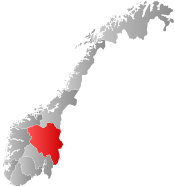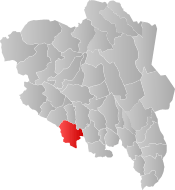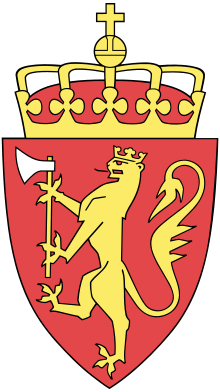Sør-Aurdal
Sør-Aurdal is a municipality in Innlandet (formerly Oppland) [3] county, Norway. It is part of the traditional region of Valdres. The administrative centre of the municipality is the village of Bagn.
Sør-Aurdal kommune | |
|---|---|
Smedlund, Sør-Aurdal | |
 Coat of arms  Innlandet within Norway | |
 Sør-Aurdal within Innlandet | |
| Coordinates: 60°41′47″N 9°39′32″E | |
| Country | Norway |
| County | Innlandet |
| District | Valdres |
| Administrative centre | Bagn |
| Government | |
| • Mayor (2003) | Knut Torgersen (Ap) |
| Area | |
| • Total | 1,109 km2 (428 sq mi) |
| • Land | 1,071 km2 (414 sq mi) |
| Area rank | 93 in Norway |
| Population (2004) | |
| • Total | 3,251 |
| • Rank | 260 in Norway |
| • Density | 3/km2 (8/sq mi) |
| • Change (10 years) | -8.4% |
| Demonym(s) | Søraurdøl[1] |
| Time zone | UTC+01:00 (CET) |
| • Summer (DST) | UTC+02:00 (CEST) |
| ISO 3166 code | NO-3449 |
| Official language form | Neutral[2] |
| Website | www |
The parish of Søndre Aurdal was established as a municipality on 1 January 1838 (see formannskapsdistrikt). The area of Bruflat was transferred from Sør-Aurdal to Etnedal on 1 January 1894.
General information
Name
The Old Norse form of the name was Aurardalr. The first element is the genitive case of the old river name Aur (now called Bøaelva) and the last element is dalr which means "valley" or "dale". The old river name is derived from aurr meaning "gravel". The name Sør-Aurdal means '(the) southern (part of) Aurdal'. (The parish of Aurdal was divided in 1805.)[4]
Coat-of-arms
The coat-of-arms is from modern times. They were granted by royal decree on 9 February 1990. It is blue with gold silhouette of the gilt-copper medieval reliquary (chasse) that is still found in the Hedal stave church, but with five blue arches inspired by the arches on a similar medieval chasse from the medieval St. Thomas Church at Filefjell[5] and representing the five Lutheran parishes of the municipality.[6] It was chosen because Sør-Aurdal is one of two municipalities in Norway that have two stave churches that are still in use. The color blue was chosen to represent the two river systems in the municipality that were historically important for the logging industry and sawmills in Sør-Aurdal.[7]
| Ancestry | Number |
|---|---|
| 28 | |
| 20 | |
| 19 | |
| 17 | |
| 16 |
Geography
Sør-Aurdal is bordered on the north by the municipalities of Nord-Aurdal and Etnedal, on the northeast by Nordre Land, on the east by Søndre Land, on the south by Ringerike and Flå, and on the west by Nes and Gol.
Sør-Aurdal is part of the traditional district of Valdres in central, southern Norway, situated between Gudbrandsdal and Hallingdal.
History
Reinli stave church (built 1190-1250) is the third church on the same location in Reinli. A new tower was added in 1685 and the building was reconditioned by the Society for Preservation of Ancient Buildings in 1885.[9]
Olaf Haraldsson traveled through Valdres in 1023, and also visited Reinli. It is assumed, then, that there was a pagan temple at the same location before the first church, some time before the year 1000.[9]
Hedal stave church was built after 1160 and in 1699 it was rebuilt and changed. An old legend says the valley was abandoned during the Black Death and the church later discovered by a bear hunter. A hide is hanging in the church, although now there is only a small part left as visitors have cut away pieces over the years.[9]
- Reinli Stavkyrkje
 Hedal Stavkyrkje
Hedal Stavkyrkje- Svartsetera, Bagn Bygdesamling
Attractions
Bagn Bygdesamling, associated with Valdres Folkemuseum is located 8 kilometres (5.0 mi) south of Bagn. It consists of twelve log houses, and a building for permanent displays. A part of the museum is at Sandviken and the farm is Bagnsbergatn.
Bautahaugen Samlinger, associated with Valdres Folkemuseum is located in the middle of Hedalen. It consists of a collection of houses and items from Hedalen. Close by is Hedal stave church.
Notable residents
- Ola Hermundsen Berge (1768-1825), folk artist
- Mikkjel Fønhus (1874-1973), author, most famous for his books about animals in the wilderness.
- Hans Jacob Stabel, priest and member of the constitutional assembly to draft and sign the Norwegian Constitution at Eidsvoll on 17 May 1814.
References
- "Navn på steder og personer: Innbyggjarnamn" (in Norwegian). Språkrådet.
- "Forskrift om målvedtak i kommunar og fylkeskommunar" (in Norwegian). Lovdata.no.
- moderniseringsdepartementet, Kommunal- og (7 July 2017). "Regionreform". Regjeringen.no. Archived from the original on 23 March 2018. Retrieved 28 April 2018.
- Rygh, Oluf (1900). Norske gaardnavne: Kristians amt (Anden halvdel) (in Norwegian) (4 ed.). Kristiania, Norge: W. C. Fabritius & sønners bogtrikkeri. p. 251.
- Now in the Bergen Museum
- Bagn, Reinli, Hedalen, Bruflat and Begnadalen
- Bakgrunnshistorien til kommunevåpnet for Sør-Aurdal (in Norwegian). Sør-Aurdal kommune. Retrieved 2009-01-03.
- "Immigrants and Norwegian-born to immigrant parents, by immigration category, country background and percentages of the population". ssb.no. Archived from the original on 2 July 2015. Retrieved 29 June 2015.
- Stagg, Frank Noel (1956). East Norway and its Frontier. George Allen & Unwin, Ltd.
External links
| Wikimedia Commons has media related to Sør-Aurdal. |
| Look up Sør-Aurdal in Wiktionary, the free dictionary. |
- Municipal fact sheet from Statistics Norway

- Map of Sør-Aurdal municipality in Kulturnett.no (in Norwegian)
- Mikkjel Fønhus biography from Dagbladet (in Norwegian)

